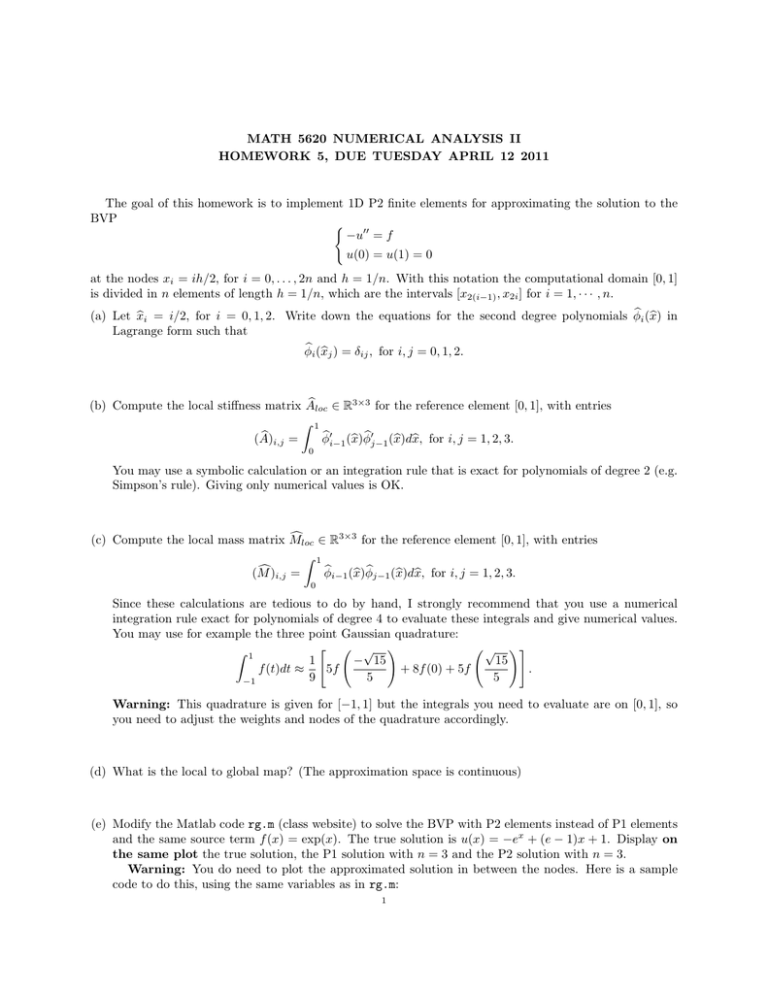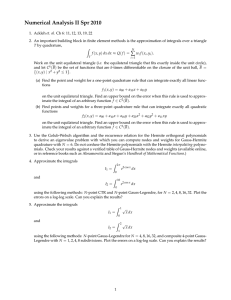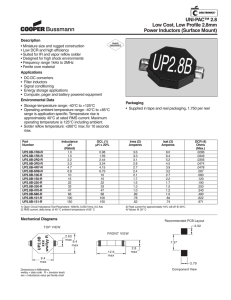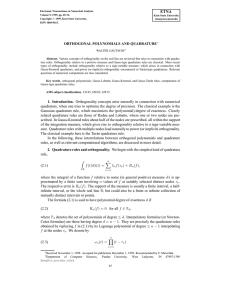MATH 5620 NUMERICAL ANALYSIS II
advertisement

MATH 5620 NUMERICAL ANALYSIS II
HOMEWORK 5, DUE TUESDAY APRIL 12 2011
The goal of this homework is to implement 1D P2 finite elements for approximating the solution to the
BVP
(
−u00 = f
u(0) = u(1) = 0
at the nodes xi = ih/2, for i = 0, . . . , 2n and h = 1/n. With this notation the computational domain [0, 1]
is divided in n elements of length h = 1/n, which are the intervals [x2(i−1) , x2i ] for i = 1, · · · , n.
(a) Let x
bi = i/2, for i = 0, 1, 2. Write down the equations for the second degree polynomials φbi (b
x) in
Lagrange form such that
φbi (b
xj ) = δij , for i, j = 0, 1, 2.
bloc ∈ R3×3 for the reference element [0, 1], with entries
(b) Compute the local stiffness matrix A
Z 1
b
(A)i,j =
φb0i−1 (b
x)φb0j−1 (b
x)db
x, for i, j = 1, 2, 3.
0
You may use a symbolic calculation or an integration rule that is exact for polynomials of degree 2 (e.g.
Simpson’s rule). Giving only numerical values is OK.
cloc ∈ R3×3 for the reference element [0, 1], with entries
(c) Compute the local mass matrix M
Z 1
c
(M )i,j =
φbi−1 (b
x)φbj−1 (b
x)db
x, for i, j = 1, 2, 3.
0
Since these calculations are tedious to do by hand, I strongly recommend that you use a numerical
integration rule exact for polynomials of degree 4 to evaluate these integrals and give numerical values.
You may use for example the three point Gaussian quadrature:
"
√ !
√ !#
Z 1
− 15
15
1
5f
+ 8f (0) + 5f
.
f (t)dt ≈
9
5
5
−1
Warning: This quadrature is given for [−1, 1] but the integrals you need to evaluate are on [0, 1], so
you need to adjust the weights and nodes of the quadrature accordingly.
(d) What is the local to global map? (The approximation space is continuous)
(e) Modify the Matlab code rg.m (class website) to solve the BVP with P2 elements instead of P1 elements
and the same source term f (x) = exp(x). The true solution is u(x) = −ex + (e − 1)x + 1. Display on
the same plot the true solution, the P1 solution with n = 3 and the P2 solution with n = 3.
Warning: You do need to plot the approximated solution in between the nodes. Here is a sample
code to do this, using the same variables as in rg.m:
1
% g r i d d e f i n i t i o n s , t r u e s o l u t i o n , s o u r c e term e t c . . .
% local basis
p h i {1} = @( x )
p h i {2} = @( x )
p h i {3} = @( x )
% local
dphi {1}
dphi {2}
dphi {3}
f u n c t i o n s in parent element [ 0 , 1 ]
SOME FUNCTION OF x ;
SOME FUNCTION OF x ;
SOME FUNCTION OF x ;
b a s i s f u n c t i o n s d e r i v a t i v e s in parent element [ 0 , 1 ]
= @( x ) SOME FUNCTION OF x ;
= @( x ) SOME FUNCTION OF x ;
= @( x ) SOME FUNCTION OF x ;
% CODE TO COMPUTE Ahat and Mhat
% MATRIX AND RHS ASSEMBLY
% solve
u = A\b ;
% evaluate function in grid
up2 = zeros ( s i z e ( x f ) ) ;
f o r e =1:n ,
% i n d i c e s o f nodes i n x f t h a t a r e i n s i d e e l e m e n t e
i i = x ( i ( e , 1 ) ) <= x f & x f < x ( i ( e , 3 ) ) ;
f o r j =1:3 ,
up2 ( i i ) = up2 ( i i ) . . .
+ u( i ( e , j ) ) ∗ phi { j }(( xf ( i i )
− x( i (e ,1) ) ) . . .
/( x ( i ( e , 3 ) ) − x ( i ( e , 1 ) ) ) ) ;
end ;
end ;
% p l o t and compare
plot ( xf , up2 , x , up1 , xf , u t r u e ( x f ) ) ;
(f) Extra credit: Produce a loglog plot comparing the L2 error of the P1 and P2 solutions for different
values of n. The abscissa should be h = 1/n and the ordinate the error ||u − uS ||, with the L2 norm. You
may take for values of n=[10,100,1000,5000]. Give estimates of the convergence rate of both methods.
2






